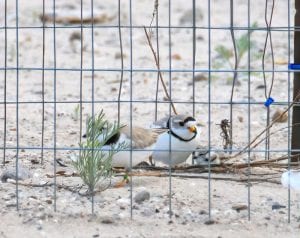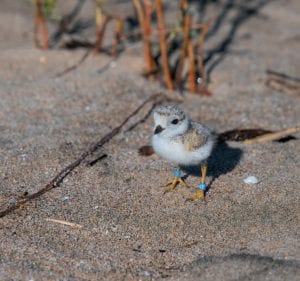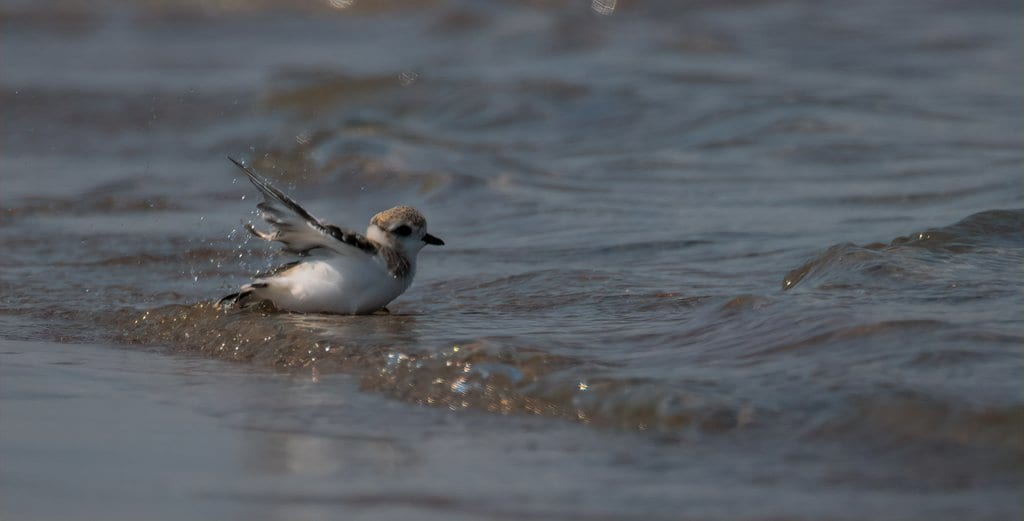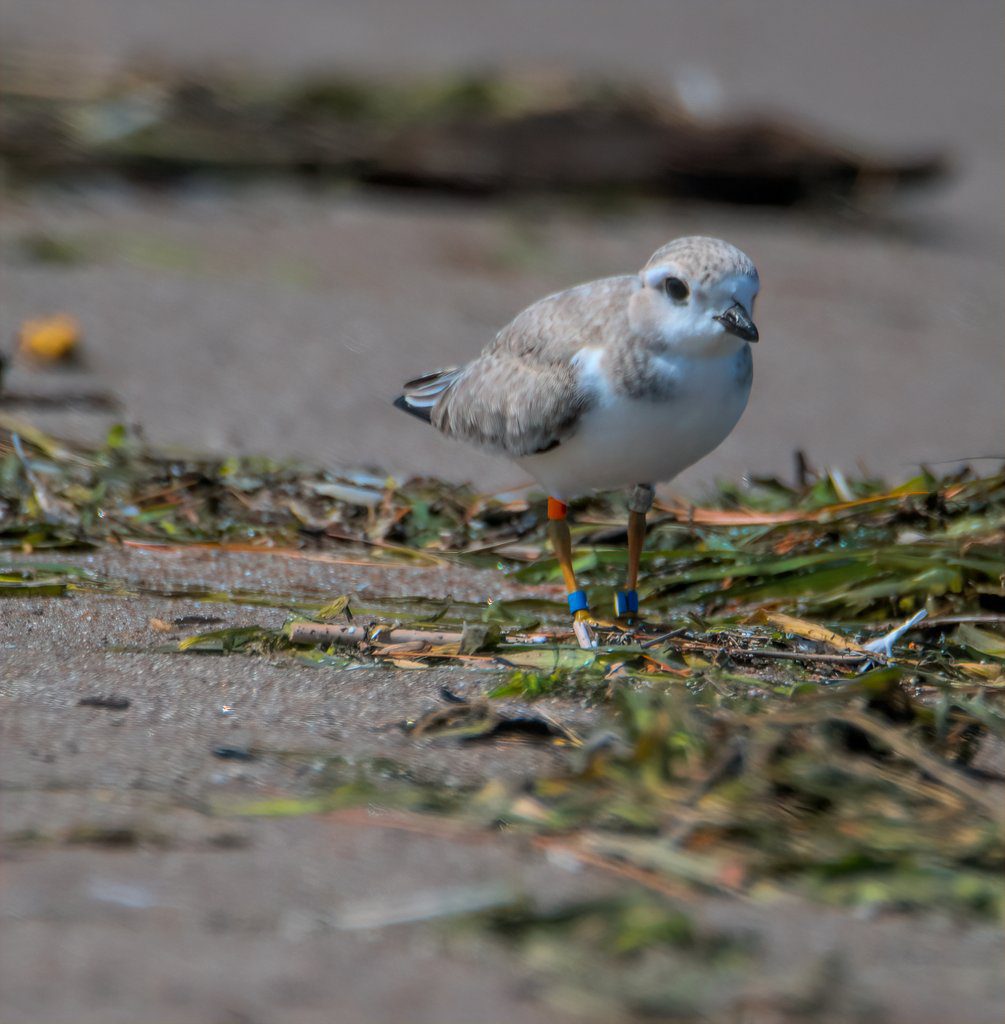April and May 2021

Fudge arrives (Image Neal Mutiger)
Exciting news! For the 14th consecutive year Piping Plovers have arrived and set up nesting sites on the shores of Wasaga Beach. Due to COVID-19 and ongoing restrictions, the Piping Plover Volunteer Program is currently on pause for the 2021 season. Wasaga Beach Provincial Park staff continue to monitor nesting sites and provide protection for the Piping Plovers by erecting perimeter fencing and predator exclosures.
Nest 1 – Fudge and Pepa
On April 19th the first plover to arrive was a returning male, identified as Fudge. He hatched in Wasaga Beach two years ago and nested along the stretch of beach adjacent to Boarkwalk 1. Favoured by our plovers since 2008, this stretch has become known as Ploverland. Fudge did not have long to wait for a mate. On April 25th the seasoned female Pepa showed up and a match was made. Pepa hatched at Sauble Beach in 2012 and nested in Michigan each year until 2016. For the past five years she has had successful nests in Wasaga Beach, pairing up with different males according to availability. Pepa has managed to persuade each of her mates to make a nest in her favourite place behind the boardwalk, requiring a detour around a short stretch of the boardwalk until the chicks hatch and move down the beach. On April 28th Fudge’s mate from last year, Nancy, showed up but it was too late – he was now fully committed to Pepa.
Pepa laid their first egg on May 12th and continued until a full there was a full clutch of four on May 18th. Incubation then began in earnest. The two adult birds continue to take turns on the nest and the eggs will likely hatch between June 12 and 15th.

Pepa on the nest (Image Neal Mutiger)
Nest 2 – Flash and Miss Sunshine
April 29th another male, Flash, arrived. Flash has been on our radar for a couple of years. After having lost a nest here three years ago, he and his mate, Tweety, spent the next two years nesting in Tiny Township. The next day, Miss Sunshine, who has been a regular at Sauble Beach, showed up and paired with Flash.
Flash and Miss Sunshine could not seem to settle on a spot in Ploverland. After spending some time in New Wasaga they moved from there to Allenwood on the boundary to Woodland and Tiny Beaches. They laid their first egg on May 15th. When the time came to erect the full-sized predator exclosure, it was noted that there were only two eggs when there should have been four. This makes it harder to calculate the hatch date as it is unclear whether they started incubating two eggs as early as May 17th. The pair are now faithfully sharing the incubation duties.
Other Birds
Two more females came through on May 8th and 12th, but also moved on when they did not find a mate here. One was a chick from Nancy and Worsley’s 2019 nest.
Birds Canada has recently provided us with news from Michigan and the Great Lakes Piping Plover Conservation Program. We are excited to know that one of our 2020 Wasaga chicks has been seen with a mate at Silver Lake State Park. Our birds really do get around!
June 2021
The excitement continues since our last update. These fascinating birds never cease to enthral.
Nest 1 – Fudge and Pepa
After faithfully continuing the incubation teamwork, on June 13th the hatching began. An adult was seen to suddenly leave the nest to dispose of an eggshell (a strategy to avoid attracting predators to the smell). The first of three chicks had arrived, followed not long after by a second. The next morning three chicks were already confidently running around and the parents had made the decision to keep them safe at the expense of the remaining unhatched egg. Before long the chicks had mastered clambering up the sand onto the boardwalk, and the time had come for the journey down to the beach.
The whole family assembled on the still closed boardwalk. First the chicks explored the ramp and peered over the edge, deciding if they had the courage to drop over onto the beach. Fudge encouraged them with ‘peeps’ that seemed to say ‘you can do it!’ And they did. Instead of opting for last year’s orderly parade down the ramp, this year they chose the short jump, landing unsteadily and somersaulting down the slope.
Before long all three were confidently crossing back and forth between the beach and the area behind the boardwalk, although once the boardwalk reopened they had to adjust to a new challenge – people! Fudge bravely distracted groups of visitors while the chicks either leapt off or ran back to safety behind the boardwalk.
Now, a week later, the family is still safe, exploring areas beyond the protection of the perimeter fence to escape the gulls and seek new and tasty insect morsels amongst the protection of the beach vegetation.

Image Neal Mutiger
Image Neal Mutiger

Image Neal Mutiger
Nest 2 – Flash and Miss Sunshine
Also faithful to their incubation duties, on June 14th, this pair quietly welcomed two fluffy chicks into the world. While it might have been considered slightly inconvenient for Park staff monitoring the birds as their second nest was so far afield, it quickly became apparent that Flash and Miss Sunshine recognized the advantages of being far from the crowds and resulting flocks of gulls at Beach Area 1. They have spent a quiet week with the admiration of some local fans, little disturbance, and plenty of camouflage afforded by the stony sand and dense vegetation. Now, a week later, their two chicks seem to be thriving well.

Image Neal Mutiger
July 2021
On June 25th the five chicks were all rounded up and experts from Birds Canada outfitted them with their indentifying bands. Parents and chicks took this in their stride. Chicks from the same nest received the same colour combinations, but with different, quite visible dot/number stamped on the lower band to distinguish them. They also received a silver upper band with a unique ID number readable on very close inspection. We do not know at this point whether a chick is male or female – this will become apparent from observing mating behaviour next spring.

Image Neal Mutiger
Following the banding the chicks have continue to thrive, foraging along the shoreline, and now that all five have surpassed the 28 day mark they are making increasing lengths of flights and are considered fledged. While it is quite common for the adult female to leave quite early in the rearing process, our two have remained as active participants along side the males throughout virtually the whole process and, like we are, I’m sure they are proud of achieving 100% survival of all the hatchlings.

Image Neal Mutiger
Now that they are fledged the youngsters are already spreading out in different directions and might be spotted coming and going to different sections of our shoreline, often alone, as they gain strength ready for migration south to their overwintering grounds – expected to happen within a few short weeks.

Juvenile Plover – Image Neal Mutiger
August 1
As the chicks gained strength for the long journey ahead, the adults gradually left them to it. Around the time Pepa left one of the fledglings had also left at around 30 days old. Perhaps it left with Pepa leading the way. Miss Sunshine followed soon after and then the males. With the adults gone, the chicks from Tiny Beach found their way over to Ploverland to hang out with the two remaining chicks there. Some days only one chick was spotted, other days all four until there was finally just one remaining. On July 26, after giving a ‘goodbye’ peep, it was seen flying out over the lake towards the setting sun, on its way to its overwintering grounds.
A few days later the perimeter fences were removed signalling the end of a successful season with 100% survival of all 5 chicks that hatched. A huge thank to Wasaga Beach Provincial Park staff for all their hard work and to Birds Canada for their support.
A total fledged in Ontario this year was 9, with the other 4 being at Darlington Provincial Park. They also had 100% survival of the 4 eggs that hatched from the one successful nest. There were some interesting shenanigans involving the one male and two other single females whose nests inevitably failed. There was a lone mystery egg at Presqu’ile Provincial Park. Sauble Beach was the scene of tragedy this year as the pair nested very late, and although the eggs hatched, the chicks were predated in short order.
We look forward to reports of Ontario chicks being spotted on southern shores and to the arrival of returning and new plovers next spring.
Great Lakes Piping Plover Population Update 2021
The most recent update from the Great Lakes Piping Plover Recovery Effort (USA) is that they had 74 pairs and 79 nests, from which they fledged 119 chicks. Eleven more are left to fledge. In addition, there are eleven chicks in their captive rearing program and another two have been released.
For more information and updates about Ontario piping plovers, visit the Ontario Piping Plover Conservation Program.
For more information on the Great Lakes population in general (USA), visit Great Lakes Piping Plover Recovery Effort.
Both groups have active Facebook sites that are updated throughout the year, and especially frequently throughout the breeding season.

Image Neal Mutiger
